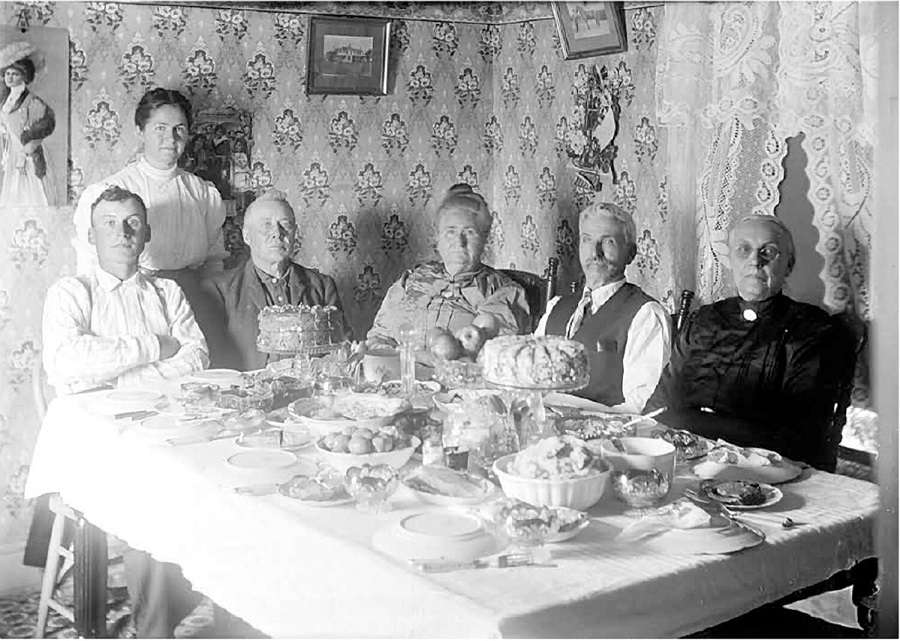The assignment for this article seemed easy, at first: Explore what the city’s early citizens of Redwood City were eating 150 years ago. As it turns out, the answer was simple, almost too simple: booze — both distilled and brewed —and oysters. Of course that’s not all that was being consumed; it would have been impossible to fuel the lumber and tannery industries that laid the foundation for Redwood City on alcohol and oysters alone. But what is now a thriving downtown of restaurants and eateries was once a collection of dirt roads dotted with saloons, breweries and oyster stands.
Redwood City was an industrial town, and single workingmen outnumbered families. After a long hard day, the men wanted to drink, play cards, and eat oysters. An advertisement for the Poplar Saloon on Main Street boasted that “The Proprietors pledge themselves that nothing shalt be wanting in the shape of Fine Wines, Liquors and Cigars, to make it the Saloon of the Place.” Billiards tables and an oyster stand connected to the saloon also meant that this was a place “where refreshment can be had at all times.”
To understand what might have influenced the more substantial meals of Redwood City’s early residents, look to the food traditions in the years leading up to 1867. This was the era of Mexican and Spanish colonization, and from the time when California was divided into large ranchos, food centered around beef, pork, corn, and beans. This is not to say that the food was primitive – quite the contrary. Helen Walker Linsenmeyer’s 1972 book, “From Fingers to Finger Bowls: A Sprightly History of California Cooking,” suggests that these early Californians, especially the wealthy ones, ate quite well. Hearty meat dishes like pork sausage and carne con chile were followed by flan, candied pumpkin and Mexican chocolate for dessert.
Gold Rush fare takes a slightly less refined turn, which makes sense in an environment dominated by men living on the land, trying to strike it rich. This might have been where oysters gained their popularity, and Linsenmeyer’s book offers abundant options for one mollusk, with recipes for steaming, frying, stewing and pickling them. Simple meat dishes, like bear steaks and even bear paws were served alongside Miner’s Baked Beans or Spanish rice. Likewise, desserts were easy-to-prepare slow-cook puddings, such as caramel and sweet rice.
It’s easy to imagine that when the “Forty-Niners” gave up on the gold game and made their way down from the Sierras to the Peninsula, the same humble fare they ate in the gold camps was what was served in boarding houses and homes as well.
So to honor Redwood City’s ancestors, crack a beer and shuck some oysters – or just go to a restaurant that serves them. Those determined to experience real deal old California recipes can try these, courtesy of Linsenmeyer’s look at the cuisine early settlers of Redwood City would have considered home cookin’ at its sprightliest.
The following recipes are from Helen Walker Linsenmeyer’s,
From Fingers to Finger Bowls: A Sprightly History of California Cooking
Gold Nugget Pork and Beans
Miners who did not have ovens could still bake a pot of beans by placing the pot in a hole beneath the campfire, though it may have required a little time and patience to keep the fire going.
1 quart white navy beans
½ teaspoon soda
½ pound salt side pork
Molasses (about 1 cup)
Salt and pepper
Boil beans with soda for 30 minutes. Drain. Wash pork and place in earthen bean pot. Add beans, salt, pepper and molasses. Cover with boiling water, set lid on pot and bake in moderate oven (350°) for six hours or until done. If necessary, add a little more water. Remove lid about 45 minutes to an hour before serving time and add more seasonings if desired.
Fried Sweet Tortillas (Bunuelos)
These unusual sweet-treats are formed like cooky balls, pressed out like tortillas, fried like fritters or doughnuts, and served with a sweet syrup, like pancakes. They still are popular at Christmastime, as they were in the days of the Dons.
3 cups flour
1 tablespoon sugar
½ tablespoon salt
1 egg
1 teaspoon baking powder
½ cup milk
2 cups fat
Sift flour, salt, baking powder and sugar into bowl. Add well beaten egg and milk, a little at a time. Turn onto a well-floured board and knead until elastic. Divide dough into 2-inch balls and roll out into thin cakes about 5 inches in diameter. Prick with fork. Fry in deep fat one at a time until golden color. Serve with sauce, made as follows:
Sauce:
1 cup sugar
2 cups water
2 teaspoons aniseed
Bring water and aniseed to boil. Add sugar, stir until dissolved and boil until slightly thickened.
This story was originally published in the January print edition of Climate Magazine.






